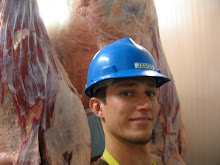
The class arrived down in the lobby, anticipating the last leg of the journey. We noticed that one of our fellows, Mr. Rick Stark had broke the code of conduct and shaved his Amazonian beard. This sorely disappointed the rest of us, especially me. I can’t grow a beard at all- and this beard growing experiment merely just showed the class how little facial hair I can produce (I like to consider that I’m just more evolved). We boarded the bus and were on our way to Northern Ecuador.
The first stop was at a major tourist attraction- the equator. Expecting a bright red line (similar to the yellow first down lines in the NFL) again I hit a major disappointment (#2 for the day). In typical Ag Leadershilp fashion, the class set into formation and we took a class photo. We were getting this class photo thing down.
Heading north, we soon were at our next stop, Hacienda La Compania de Jesus. This hacienda was a very interesting stop- we had coffee (the best all trip) and snacks awaiting us as we arrived. Also throughout the house were elaborate bouquets of roses. These Ecuadorians sure know how to grow a rose. Massive bouquets were located throughout every room in the house. We took a tour of the grounds, including their own chapel. We had a little girl walking around and giving us each one rose… and once again, the mandatory class photo and we were back on the road.

Arriving in Otavolo, we could barely make out the mountains (volcanoes) surrounding us amidst the fog and mist. The first stop was for lunch at a place famous for its Cuy (guinea pig). Looking over the menu, there were many options to choose from- the mandatory Cuy, rabbit, blood sausage and other mystery meats. I was being adventurous (as usual) and ordered the combo plate, which consisted of all of the above. I also tried some fried Cuy livers as an appetizer, and let me tell you, that was some appetizer!
After a very large lunch we were ready to visit the Universidad Technica del Norte- the main agricultural university in Northern Ecuador. We unfortunately were on a bit of a time schedule, but were treated to a great tour regardless. The highlight of this particular tour was the cuy production facility. Little did we know we’d see confined cuy. We took a quick walk down to some grain production trials. This school contained 500 agricultural students led by 25 faculty members. This university was very well maintained, unlike the university farm we visited in Cusco, Peru. You could feel the pride that the students had in their projects.
After the university visit, we had a special treat lined up for us. We had representatives from the Benson Institute, a group that has developed a nutrition program in rural Ecuador. This program analyzes current diets and works with families to help integrate other crops and livestock into their diets to help improve their health. We had a few family visits and were able to see this first hand. The institute would provide things such as technical support, seeds and seed stock livestock. One family for example were provided a few cuy and grew that into a thriving enterprise of 90 cuy.


The family visits wrapped up and we hopped back on our busses. We headed to the Hacienda Cuisin, the location of our final night on our trip. When we arrived at the site, I was pleasantly surprised. The grounds were expansive and immaculately manicured. We walked around and checked out everyone else’s rooms. Many of the females in our class had their own cottages… this place was great! We cleaned up and met for our finale dinner.
We had a large banquet room all to ourselves. The food was great, but the toast was the highlight of the night. None other than Mr. Peterangelo Vallis gave an elaborate toast to the class. There is no way I can capture this moment in words, or even by pictures. Peter, with glass of wine in hand, roved around the room, and told the many stories that we had from our experience that was coming to an end. Fellows were dropping like flies due to the hysteric laughter. We saluted ourselves in one last great toast, here’s to a great trip!
















































